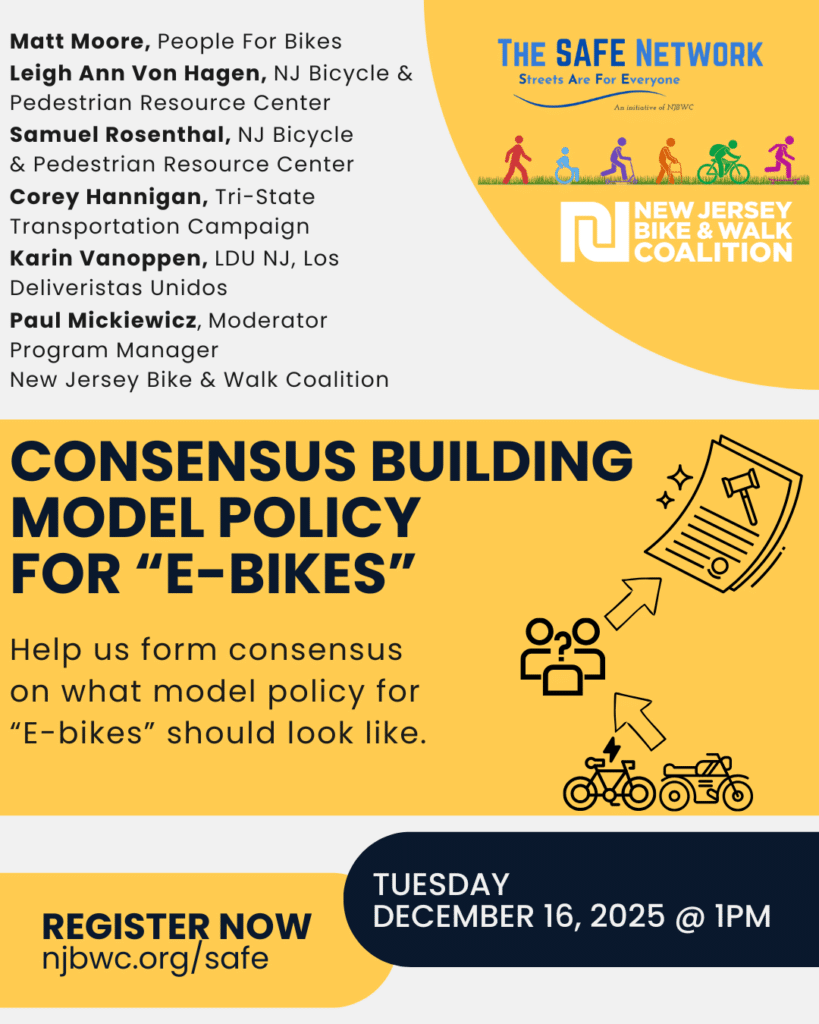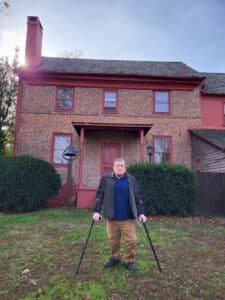Consensus Building Model Policy for “E-Bikes”
Tragic headlines of teen e-bike rider crashes have municipalities scrambling to pass new ordinances to address this legitimate concern. Although well intentioned, these new laws are often misinformed, overly restrictive and are a disproportionate response to the true cause of roadway fatalities. With many applicable laws already in place but unknown or misunderstood does it make sense to create more bureaucracy related to this issue? Can we simplify terms to improve understanding? Hear from our panel of experts and share your thoughts on what model policy for “E-bikes” should look like.
Panelists
- Matt Moore, People For Bikes
- Leigh Ann Von Hagen, New Jersey Bicycle & Pedestrian Resource Center
- Samuel Rosenthal, New Jersey Bicycle & Pedestrian Resource Center
- Corey Hannigan, Tri-State Transportation Campaign
- Karin Vanoppen, LDU NJ, Los Deliveristas Unidos
Moderator
- Paul Mickiewicz, Program Manager, New Jersey Bike Walk Coalition

Thanks for joining the webinar. The recording is now available!
The SAFE Network (Streets Are for Everyone) is a community of bike & walk friendly advocates, members of like-minded partner agencies and community leaders, inspired to create safe streets.
Local advocates are at the center of the movement to make our streets safer for all users. Making our roadways safe and comfortable for active transportation is part of the solution to many of our most pressing challenges. It helps reduce traffic violence, creates more equitable mobility options, creates healthier, more environmentally friendly, sustainable communities and improves our quality of life.
Building on the Bicycle and Pedestrian Advocacy Network, which grew out of our 2021 Summit, this network incorporates new strategies, policies, and opportunities for funding that have been introduced nationally over the past two years.
Our network utilizes the foundational strategies and resources from the US DOT Safe System Approach, Vision Zero, and Complete & Green Streets for All, to build our capacity to work with municipal and county government, advocacy groups and partner agencies to create safer streets, particularly for our most vulnerable road users.
The SAFE Network includes:
- Monthly group meetings with presentations, guest speakers, discussions, and networking.
- Online Support sessions customized to address any of the SAFE Network Advocacy resources or advocacy efforts in your community.
- NJBWC SAFE Network Resource Center on our website.
Target Zero Commission
Updates from the Target Zero Commission including webinars, Q&A, and information from agencies.
SAFE Network Webinar Materials
Resources from the New Jersey Bicycle & Pedestrian Advocacy Network.
Advocacy Support
This support will include presentations, web based resources and discussion to educate and advise local advocacy efforts.
Vision Zero & Safe Systems Approach
Infographics, guidelines and more documentation regarding advancing Complete Streets through a Safe Systems Approach.
Complete & Green Streets Policy
These policies prioritize health, equity, and fairness in transportation expenditures and project selection.
Demonstration Projects
Demonstration or pilot street projects are temporary design strategies, tools and tactics that cities and towns can use to explore possible solutions or improve their roadways and public spaces in the near-term.
The Need for Speed Reduction
Resources vital to advancing mobility, access, equity, and safety for pedestrians and bicyclists.
Funding Opportunities
A comprehensive list of funding resources for Active Transportation in New Jersey.
For more information or to schedule an appointment, contact Paul Mickiewicz, SAFE Network Program Manager Paul.Mick@njbwc.org














































































